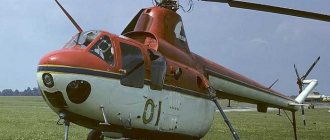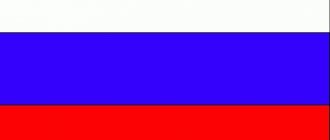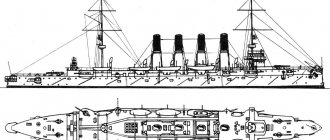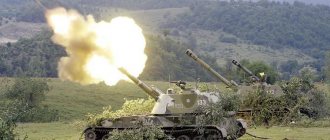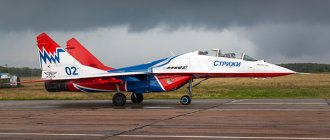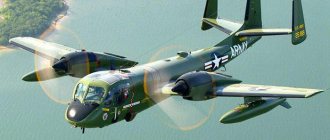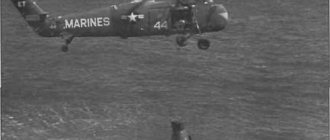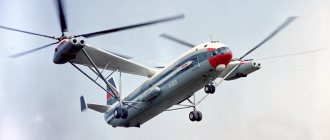The calling card of the Nikolai Kamov Design Bureau was (and remains) coaxial aircraft. The structural complexity of such a design is compensated by the small dimensions of the aircraft and high maneuverability. In many ways, it was these qualities that contributed to the fact that Kamov helicopters firmly “settled” in naval aviation. Mainly in the military.
One of the design bureau’s most famous developments was the Ka-50 “Black Shark.” Unfortunately, it did not gain much popularity. But the most successful development of that period, which allowed the plant to survive in difficult times, was probably the multi-purpose Ka-27 helicopter and its civilian version, the Ka-32.
History of creation
In the 60s, the design bureau of Nikolai Kamov developed and launched into production the successful Ka-25 helicopter. However, the scope of application of this machine remained quite limited. “Twenty-fifth” was actively used in the navy, but had practically no modifications for the national economy.
But the successor to the Ka-25, designated Ka-27, was originally conceived as a universal helicopter for solving a wide range of tasks. Its basic modification remained the anti-submarine version, but a draft national economic version was also prepared.
The first flight of the prototype (common to all major modifications of the platform) occurred at the end of 1973.
In 1980, the production model of the Ka-32 flew for the first time, and in 1981, the new machine was demonstrated to the general public for the first time.
Operators
- Russia
- Republic of Korea: 63 Ka-32T/S and Ka-32A, of which 9 are in service with the Marine Police and 7 in service with the Air Force as search and rescue helicopters. 31 Ka-32s are operated as firefighting helicopters by the Korean Forest Service. In addition to them, 15 Ka-32s are used by various civilian companies and departments.
- Ukraine
- Bulgaria
- Azerbaijan: 6 Ka-32 for the Ministry of Emergency Situations
- Canada
- Spain: 10 Ka-32A11BC firefighting helicopters.
- Portugal: 6 Ka-32A11BC firefighting helicopters
- Switzerland
- Japan: 1 Ka-32A11BC
- Kazakhstan: 2 Ka-32A11BC purchased for the Ministry of Emergency Situations.
- Brazil
- Türkiye: 3 multi-purpose Ka-32A11BC helicopters
- * DPRK
Design
The Ka-32 multi-purpose transport helicopter is a civilian modification of the Ka-27 anti-submarine helicopter, and in design it is almost no different from it. The fuselage is an all-metal semi-monocoque of beam-stringer construction, consisting of a cockpit, cargo compartment, tail section and engine nacelle.
The pilot's cabin is 2-seater, with sliding doors on the sides. Inside the cargo compartment, folding seats are installed along the sides - there are 16 of them in total. The sliding compartment door is located on the left side, closer to the tail. The tail section itself serves as a compartment with equipment.
The power plant of the “thirty-second” is 2 TV3-117VMA gas turbine engines. This is a high-altitude modification of the famous engine, developed back in the 80s for the Ka-50 attack helicopter. Engine control is automatic; in case of automatic failure, auxiliary control is used - manual.
Torque is transmitted to the screws by a planetary 2-stage gearbox, equipped with its own cooling system.
The engine nacelle also contains the AI-9 auxiliary power unit - a small gas turbine that powers the air starter that starts the engines.
The three-bladed propellers are folding, their blades are fiberglass, and the plastic is reinforced with carbon fiber. The screw bushings, made of steel and titanium, are equipped with vibration damping devices, which reduces vibration levels. The tail of the Ka-32 consists of a stabilizer and two keel washers with rudders and slats.
Fuel tanks are mainly located under the belly, but 2 are located in containers along the sides of the fuselage. The Ka-32 landing gear is non-retractable, with 4 legs. In case of emergency splashdown, inflatable balloons can be suspended from the sides, providing the helicopter with some buoyancy. The Ka-32 flight equipment not only provides automatic stabilization, but even allows you to perform an automatic landing approach.
Recorders have the answer
Today the board should be raised to the surface - the helicopter is at shallow depths. Honored Military Pilot of the Russian Federation Vladimir Popov told “360” that during the ascent from the plane, recording devices and on-board objective monitoring equipment will be removed, which will help determine the causes of the accident.
“It’s too early to say. But if the crew did not send distress signals, did not communicate and did not warn the dispatcher, most likely a combination of two factors. The first is the human factor; it will always be present. The second was some kind of failure, a mismatch in the operation of the systems,” explained Vladimir Popov.
The fact that the flight took place over the sea could also have influenced it. This always comes with additional danger, the expert noted. It is possible that even in good weather the wind conditions could change sharply, and this affected the piloting. Air humidity and evaporation from the sea could also play a role.
The pilot added that now there is an opportunity to talk with the crew. According to the expert, the deceased on-board technician was in the cargo compartment cabin, so it was more difficult for him to evacuate. It is possible that the technician was not wearing a seatbelt, was hit and lost consciousness - this could very well lead to death in the water.
Modifications
Historically, the first modifications of the Ka-32 helicopter were the Ka-32S and Ka-32T. The first option was intended for servicing ships (usually in arctic conditions) and oil rigs. The Octopus navigation radar, rescue and sanitary equipment were installed on it. The Ka-32T is a transport, “simplified” version, devoid of radar and special equipment. On its basis, the Ka-32K “flying crane” was built, with an additional operator’s cabin and a new fly-by-wire control system.
Unfortunately, things didn’t go further than the prototype.
The modernized Ka-32 received the index “A”. In order for the aircraft to meet international requirements, it had to improve its instrumentation. Subsequently, the Ka-32A became the basic modification. On its basis, the Ka-32A1 firefighting helicopter was created. The Ka-32A2 variant should have been of interest to law enforcement agencies and used, including for the landing of special forces. But only 1 copy was built, and even that was later converted into a regular transport.
One of the last export modifications of the "thirty-second" was the Ka-32A11BC. It was distinguished not only by modernized instrumentation, but also by an increased service life of its components. Since 2011, this option has become the only base model. The number of unrealized projects based on the Ka-32 included a passenger helicopter with an enlarged fuselage, which contained a comfortable passenger cabin and a vehicle with a payload capacity increased to 7 tons.
Assistant to sailors and rescuers
Photo source: wikipedia.org
At the same time, Vladimir Popov called the Ka-32 one of the most reliable domestically produced helicopters. And although more than 20 accidents have occurred with a helicopter of this model since 1987, this, according to the expert, is a small number for aviation.
“All this had its explanations: somewhere there were human mistakes, somewhere there were equipment failures. The failure of one engine is already an accident. But this helicopter model has two engines, and the second, although the thrust drops, makes it possible to make an emergency landing. There may be a failure in the propeller pitch adjustment system, but it is still possible to land the aircraft,” the pilot explained.
The helicopter has proven itself well due to its ease of piloting, good maneuverability, ergonomics and successful design. According to Vladimir Popov, this machine meets all the requirements of today. That is why the helicopter is so readily used by the Russian Navy and the Ministry of Emergency Situations.
“In Navy aviation, it is used as a search and rescue aircraft, reconnaissance aircraft, for anti-submarine defense, and as a transport - the vehicle can carry up to 15 passengers if necessary. In addition, the Ka-32 needs a fairly small landing area, and a small hangar is suitable for storage,” the expert said.
Helicopters and rescuers appreciate them. Due to two pairs of propellers that rotate in different directions on the same axis, the helicopter's blades are shorter than usual. Thus, it can, unlike other helicopters, get quite close to a burning multi-story building. Plus a large carrying capacity, the pilot noted.
Exploitation
The use of Ka-32 helicopters began long before their launch into production.
In 1978, an experimental helicopter proved its high performance qualities by participating in the escort of the icebreaker “Sibir” along the Northern Sea Route.
Then, in the period from 1983 to 1985, several world records were set on the “thirty-second” - in rate of climb, flight altitude and load lifting height. Moreover, all records were set by the female crew.
In 1986, shortly after the start of mass production of the "thirty-second" and its international debut at the Le Bourget air show, the helicopter came in handy in eliminating the consequences of the Chernobyl disaster. The high maneuverability of the Ka-32 when flying with a suspended load made it possible to use it to lower sensors into the exhaust pipe of a power unit.
Subsequently, after the collapse of the USSR, the “thirty-second” continued to be actively used in Russia and the CIS countries. And not only: Ka-32 firefighters fly in Spain and Portugal, Kamov Design Bureau vehicles were actively purchased by Canada and Switzerland, and in South Korea the “thirty-second” was even put into service.
Climate apocalypse
Every year fire destroys tens of thousands of hectares on our planet. There is no mercy from the elements for anyone: neither Russia, nor Bolivia, nor Canada, nor Brazil. In 2022, the area of forest fires in our country amounted to 18.2 million hectares, which is comparable to the area of Sri Lanka, and became a record since the beginning of the 21st century.
Scientists' forecast is disappointing: fires in forests will ignite, and the area of fire will increase every year. Extreme natural phenomena are to blame. Heat, prolonged absence of precipitation and strong winds arise due to rising temperatures on Earth. Therefore, the battle against unprecedented forest fires is still ahead.
Flight performance
There are not many coaxial helicopters in the world, and comparing the Ka-32 with single-rotor aircraft does not seem to be very correct. But you can compare its parameters with the performance characteristics of the American S-70 helicopter, the civilian version of the famous Black Hawk. This vehicle is used, among other things, as a firefighting and marine vehicle.
| Ka-32 | Sikorsky S-70 | |
| Main rotor diameter, m | 15,9 | 14,1 |
| Length, m | 11,3 | 17,1 |
| Take-off weight, t | 11 | 7 |
| Maximum speed, km/h | 260 | 361 |
| Load capacity, t | 5 | 4 |
The advantages of the coaxial arrangement are obvious - the Ka-32 is smaller in size (especially with folding propellers), and its payload capacity is higher. The worst speed characteristics for cars of this class are not decisive.
Development of the Ka-32 began back in the 60s, but it was only possible to launch it into production in the mid-80s. Nevertheless, it still remains a popular car, superior to its competitors in a number of characteristics.
If we remember that the “thirty-second” itself is one of many variants of the Ka-27 helicopter, we can conclude: the Kamov team then managed to design a truly outstanding machine, comparable in level of perfection to the Mi-8.
sea soul
Not every helicopter is capable of performing tasks at sea. Of course, we are not talking about flights along the coastline based on ground-based sites, but about the machine being serviced in ship conditions, standing on an open platform (at the stern of the ship) and serving the current requirements for reconnaissance and warning of the naval command. In this case, the technical regulations become seriously complicated; splashes of salt water and severe atmospheric influences can adversely affect the operation of mechanisms, components and assemblies. The Soviet military doctrine of the late forties in terms of possible ocean operations was in a state of development, so Kamov's bureau from the moment of its creation worked in two directions. Firstly, the machines developed here must be suitable for use on aircraft-carrying ships. Secondly, their purpose, due to the uncertainty of future intentions, was assumed to be broad, that is, multi-purpose. These requirements were met by the Ka-8, Ka-15, Ka-25, Ka-26 and especially the Ka-32 - a helicopter most suitable for sailors, firefighters, builders, installers and many other peaceful workers working in the most difficult conditions, in including in humid climates, from polar latitudes to the tropics.
Ka-32 for export
The success of the machine's design is confirmed by the success it enjoys at world air shows, where the Ka-32 helicopter was exhibited and demonstrated. Photos of rotorcraft with South Korean, Canadian, Malaysian or Swiss identification marks do not surprise anyone. A feature of this example of the Soviet and Russian aircraft building school is traditionally reliability, ease of control and ease of training for foreign pilots.
The vehicle has a high modification and modernization potential; the most modern avionics can be installed on it as they become available, which ensures the Ka-32 a long celestial life.

